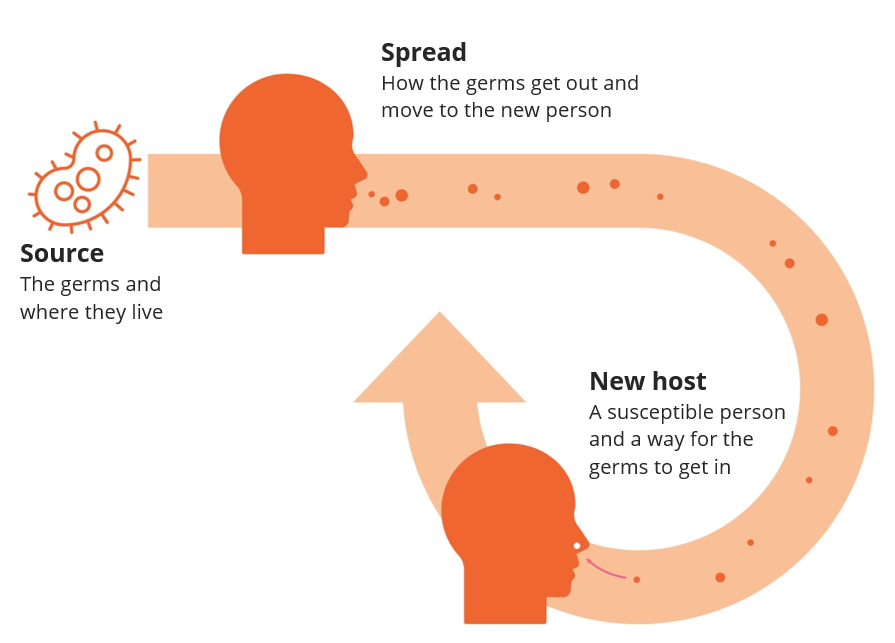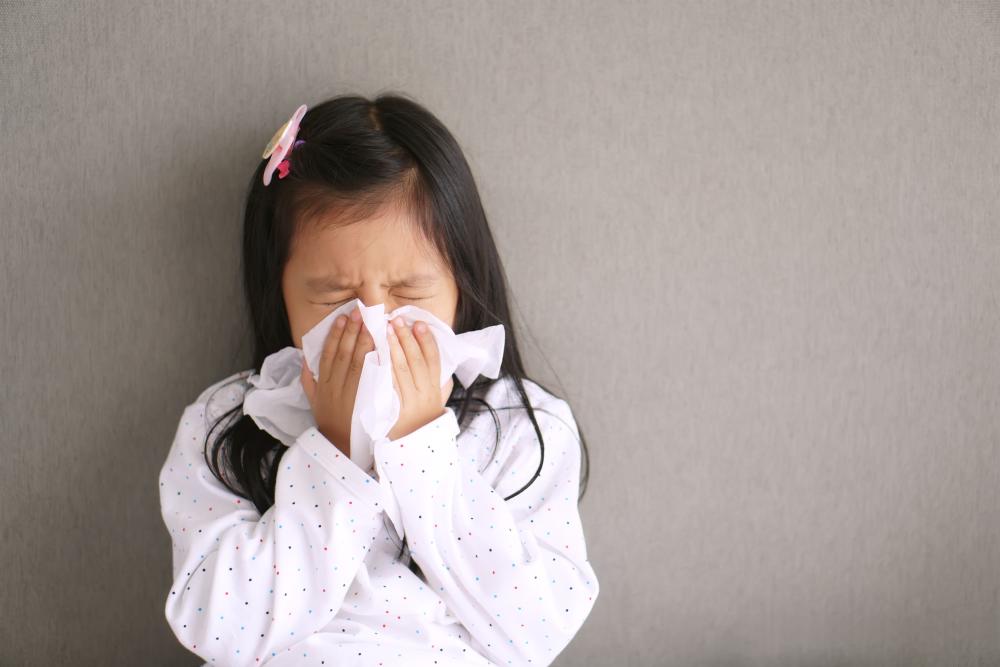This section explains infections, their causes, and how you can break the chain of infection.
Understanding Infection
1.1 How infections occur
An infection occurs when harmful germs (microorganisms) enter the body, multiply and cause disease.
The chain of infection refers to how germs spread (Figure 1.1). When an infection occurs, three things are involved:
- the source – the germs and where they live
- spread – how the germs get out of one person and move to a new person
- the new host – a susceptible person (someone who can be infected) with a way for the germs to get in.
All the steps in the chain need to occur for germs to spread from a source to a susceptible person. By breaking the chain at any stage, you can prevent the spread of infection.

Source
There are 3 major types of harmful germs responsible for human infections: bacteria, viruses and fungi. Parasites can also cause disease or other negative effects in humans.
- Bacteria are found almost everywhere, including in and on the human body. Most bacteria live in close contact with us and our environment without causing any harm. Some are even good for us – good bacteria live in our intestines and help us digest our food. But some bacteria can infect the body and cause disease. Bacterial diseases include streptococcal sore throat, impetigo (school sores), whooping cough (pertussis) and meningococcal infection.
- Viruses can only grow and reproduce inside other living cells. Viruses cause diseases such as the common cold, flu, COVID-19, gastroenteritis, chickenpox (varicella) and measles.
- Fungi generally do not cause disease in humans. However, some can cause skin and soft-tissue infections such as tinea corporis (ringworm), tinea pedis (athlete’s foot) and candida (thrush). Some fungi may also cause serious infections in people with compromised immune systems.
- Parasites are organisms that live off or in another organism. Parasites can be harmful to humans and can cause diseases. Most parasites that cause disease in humans come from one of 3 categories.
- Protozoa are single-celled organisms. Those that cause gastroenteritis usually live in water (for example, cryptosporidium and giardia).
- Ectoparasites live on the surface of the human body (for example, infestations of scabies and head lice). These parasites can cause a local reaction that leads to itching.
- Helminths are parasitic worms (for example, pinworm and roundworm). They can cause intestinal infections in humans.
Bacteria, viruses, fungi and parasites live in humans, animals, insects and the environment. These can all be sources of infection.
Generally, people are most infectious when they are sick and showing symptoms (for example, sneezing, coughing, vomiting or having diarrhoea). But not all people with infection show symptoms of illness. They may be infectious before they become sick, during their illness or after they have recovered.
An example is gastroenteritis. Children, educators and other staff who no longer have diarrhoea may still shed germs in their faeces for some time. Although this means they are still a potential source of infection, the spread of disease can be prevented if everyone in the education and care service follows good infection control practices.
Spread
Germs spread in several ways.
First, germs get out of their current host – for example, through saliva or cuts in the skin. They then travel to a new host. The ways that germs travel are known as their modes of transmission. Several modes of transmission are likely in education and care services.
- Exposure to coughing or sneezing (droplet transmission) – When an infected person sneezes or coughs, tiny droplets spray from their nose and mouth. These droplets can spread up to 2 metres before dropping to the ground. The droplets may land on the mouth or nose of another person if they are close to the source, or a person may touch a surface contaminated with the droplets, then touch their mouth, eyes or nose. Droplets help spread many viral diseases such as the common cold, as well as bacterial diseases such as whooping cough and meningococcal infection.
- Breathing contaminated air (airborne transmission) – Airborne (or aerosol) transmission is due to germs in very small particles that are so light they remain suspended in the air for a long time. These particles are created when an infected person breathes, talks, sings, coughs or sneezes. The particles can be carried in the air for long distances, so they can infect people who have not had close contact with the source. Examples of airborne germs include the measles virus, the chickenpox (varicella) virus and COVID-19.
- Direct contact (contact transmission) – Some germs or parasites can spread through touch. These include head lice (head-to-head contact) and bacterial and fungal infections of the skin (skin-to-skin contact). Germs and parasites can also spread through contact with body fluids, such as urine, faeces, mucus, saliva, vomit, blood and breastmilk. They can enter the body by contact with the eyes, nose, mouth or broken skin.
- Indirect contact – Surfaces such as benches, tables, door handles, toys and toilets can be contaminated when a person with an infectious disease touches them, or coughs or sneezes on them. If a person touches a contaminated surface and then touches their mouth, eyes or nose, they can become infected.
- Animals – Contact with animals can spread disease. Germs can be present on the skin, hair, feathers and scales of animals, and in their faeces, urine and saliva. These germs may not cause disease in the animal, but they may cause disease in humans. Some germs can multiply in insects such as mosquitoes, fleas and ticks and spread through the insect’s bite. Insects that carry the germs are known as ‘vectors’.
- Food – Food can be contaminated when a person with an infectious disease touches, coughs or sneezes on it. Food can also be contaminated at any point along the supply chain (farm, production, transport and preparation). If the food is not stored or heated or chilled properly, the germs can multiply in the food and spread to people who eat it, causing disease.
New host
When the germ has reached another person, it may enter the body through the mouth, nose, eyes or broken skin. Whether a person becomes sick after the germ has entered the body depends on both the type of germ and the person’s immunity.
People with weakened immune systems may develop severe diseases from germs that may be harmless or cause only mild infections in people with normal immune systems.
Vaccination helps the immune system to fight certain diseases (see section 2.1 Immunisation). It can either prevent the disease from developing or reduce the severity of disease. Ensuring vaccinations are up to date gives the best protection against these diseases.
How infections spread in education and care services
The way that children interact with each other and with adults in education and care services means that diseases can quickly spread. Children, especially younger children, have close contact with other people through playing or care and comfort routines. They often put objects in their mouths, and they do not always cover their mouth and nose when coughing or sneezing. Because some harmful germs can survive on surfaces, children may touch a contaminated surface, then put their hands in their mouth and become infected.

1.2 Breaking the chain of infection
Infection control practices are actions that can break the chain of infection (Figure 1.2).
The most important actions to break the chain of infection and stop the spread of diseases are:
- personal strategies – actions you can take for yourself or in interactions with other people (see Part 2 Preventing infection)
- immunisation
- hand hygiene
- respiratory hygiene
- wearing gloves and masks
- nappy changing and toileting
- safely dealing with wounds and body fluids
- taking care with animals
- protecting pregnant staff and visitors
- environmental strategies – actions you can take to improve the environment (see Part 3 A healthy environment)
- ventilation
- cleaning
- food safety
- exclusion – action to limit infection sources (see Part 4 Managing infection).

For many diseases, you may need to use several control measures to reduce the risk of spreading. For example, for respiratory viruses, measures that could reduce the risk of spreading infection in a service include all the recommended personal strategies plus good ventilation and frequent cleaning of surfaces, kitchens and bathrooms. Mask use may be mandated or recommended by public health authorities if there is an outbreak of specific diseases.
Always following all the steps to break the chain of infection, and using extra protection when required, is the best way to prevent spread of infections in education and care services.
These are practices that everyone can follow to reduce the risk of infection for themselves and those around them, but children or infants may not be able to maintain hygiene standards on their own. Educators and other staff must help children with toileting, hand hygiene and respiratory hygiene.
Staff should also be aware of their own hygiene practices so they can model safe behaviours to children. Early childhood education and care settings provide great opportunities to teach or reinforce good hygiene habits in children and give them lifelong habits that will reduce the spread of infection in our communities.
